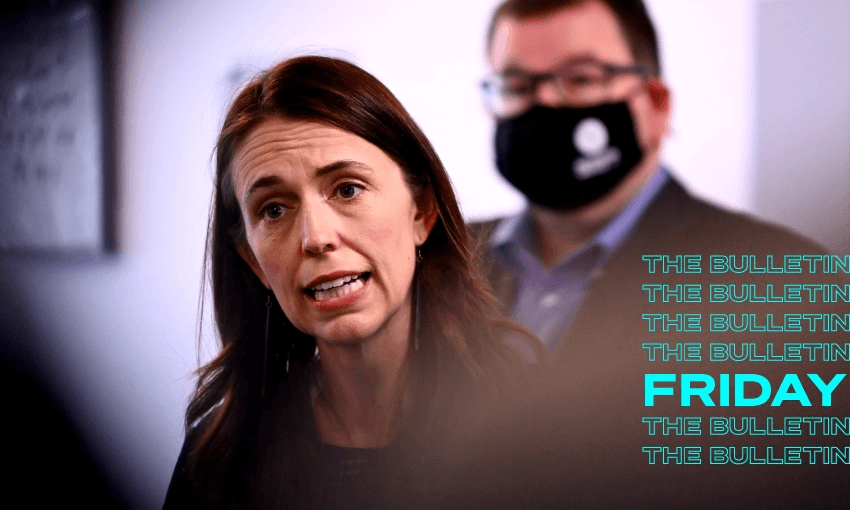A national red light setting and some tinkering around the rules should get us through omicron said Ardern, but warns there will be an unprecedented number of cases, Justin Giovannetti writes.
A different approach to Covid-19. New Zealand will move to the red setting of the traffic light system within 48 hours of a community case of omicron being detected, but there won’t be lockdowns, Jacinda Ardern confirmed yesterday. The prime minister sketched out a very different response to this variant. There won’t be elimination or containment, instead, she told New Zealanders that this is their time to prepare personally to deal with a Covid-19 infection. Despite a media statement from the prime minister’s office headlined “NZ prepared for omicron,” Stuff reports that Ardern wasn’t yet ready to unveil most of cabinet’s plan to deal with the variant.
“We need everyone to think about how they can prepare. For families, make sure your vaccines are up to date and everyone who is eligible is boosted. Think about what you need at home if you are required to isolate,” said the prime minister, speaking from the Labour caucus retreat in New Plymouth.
What does this mean? Omicron will cause case numbers higher than New Zealand has seen before, the prime minister warned. The Auckland region alone could see 1,800 daily cases, but as Stuff writes, that number has been labelled as conservative.
Perhaps what is surprising about the government’s plan is what wasn’t announced yesterday. There were no changes to the traffic light system, no big push on rapid tests or an increase in mask quality. The last two have become significant overseas, with some countries offering their residents universal access to free rapid tests and good quality N95 masks. There was also no announcement on the border, despite new MIQ bookings being postponed indefinitely this week pending a decision by cabinet.
The plan. Instead, Ardern promised in the coming days that new rules will come out on case management, the definition of close contacts and new testing requirements. As the NZ Herald reports, the prime minister said hospitals are ready for omicron after the delta outbreak. A leaked report from Auckland DHBs earlier this week showed that less than a third of ICU beds are currently available.
Reflecting on the prime minister’s comments, I have to admit it finally sunk in what’s about to happen. This country eliminated the first wave of Covid-19 and then contained delta at levels far below the dire warnings. Surely that’ll just happen a third time? It likely won’t. While I’ve written in this newsletter over previous days of the warnings and red lights from the Beehive, it’s still hard to imagine a New Zealand with thousands of daily Covid-19 cases.
An expert reaction. Jennifer Summers, an epidemiologist from the University of Otago, said the current traffic light system was designed for delta and “is not fit-for-purpose” to respond to omicron. The three light system leaves high-risk individuals and communities with less protection, she told the Science Media Centre. She also called the decision to rule out lockdowns and regional boundaries “short-sighted.” Finally, she said the government should not be waiting for community spread to respond, but should be proactive.
The future of rapid tests. A number of my friends and family overseas who have tested positive for omicron in recent weeks learned from rapid tests. They’ve been proven indispensable when traditional testing systems have been overrun by tens of thousands of daily cases. The prime minister said that the government is planning to introduce the test more widely in the coming weeks, but there are only 4.6 million in the country right now. More frequent testing will be needed in “a high-transmission environment,” she added. The current supply could be used up in as little as a week of outbreak. As RNZ writes, National leader Christopher Luxon called the government’s rapid testing rollout “appallingly slow” and less than one test per person won’t cut it. Rapid tests are currently only available to asymptomatic, unvaccinated domestic travellers.
Industry calls for more financial support to face omicron. While businesses can remain open to smaller groups of vaccinated customers under the red setting, the NZ Herald reports that Auckland business leaders say they’ll need financial support if they can’t host large events. Retail and hospitality in Auckland fear they’ll get hit again. For a vision of what might await New Zealand, look across the Tasman. The Guardian reports that Australian prime minister Scott Morrison has proposed allowing children to drive forklifts to help ease a staff crisis that has hit supply chains and supermarkets. Most state premiers have responded with amazement. One former union boss reminded the prime minister that forklifts are really dangerous, “they are not dodgem cars.”
This is part of The Bulletin, The Spinoff’s must-read daily news wrap. To sign up for free, simply enter your email address below
